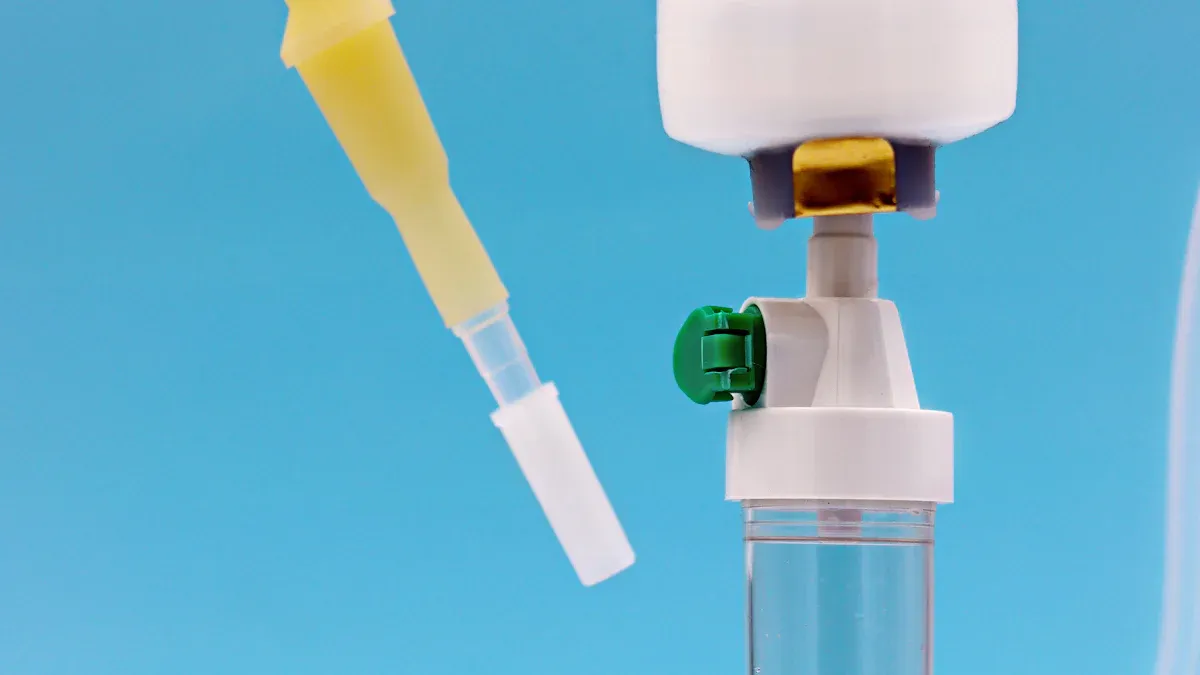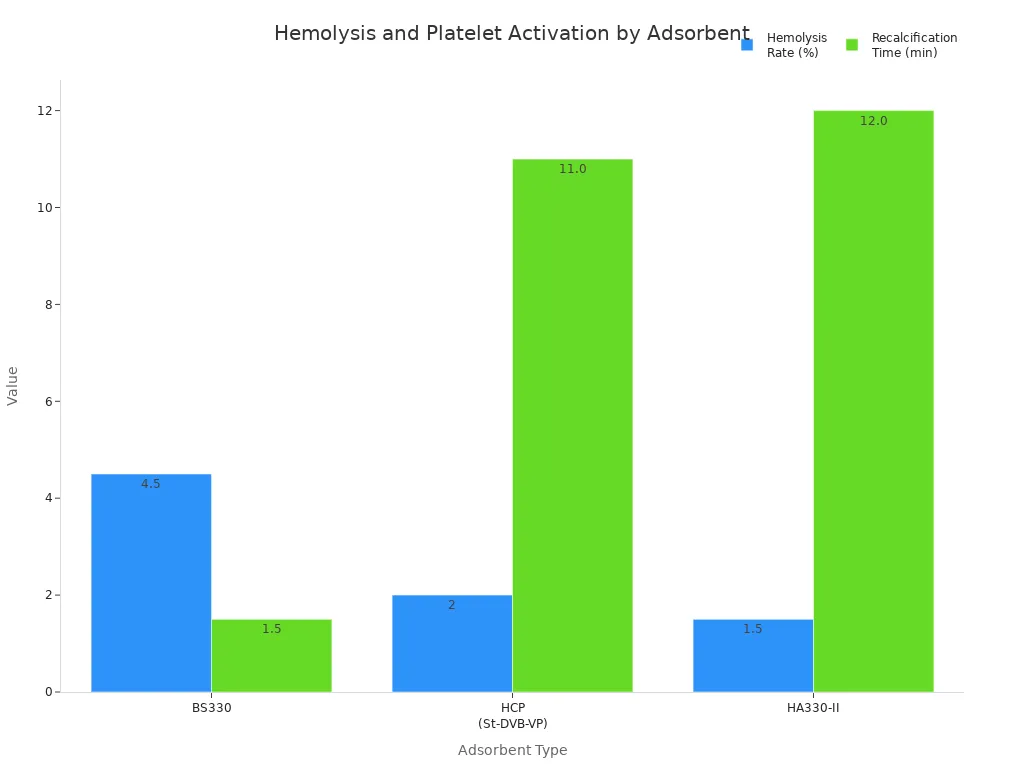
Charbon actif pour la purification du sang helps take out bad things from your blood. This special material uses adsorption. That means it grabs and holds toxins on its surface. Doctors have used activated carbon for many years to clean blood safely. You can trust it because experts check these materials for safety and biocompatibility. Strict rules guide every step to keep you safe.
Activated carbon’s special structure makes it a strong tool for safe blood purification.
Principaux enseignements
Activated carbon takes toxins out of blood by adsorption. This makes it a safe way to clean blood.
Il y a différents types de charbon actif. Powdered and granular types work in special ways. They are good at catching harmful things.
Safety is very important. Activated carbon is checked for purity and biocompatibility. This makes sure it does not hurt blood cells when cleaning blood.
Activated carbon can be used with other treatments. For example, it can be used with hemodialysis. This helps remove toxins that other methods do not catch.
Scientists are still studying activated carbon. They want to make it work better and safer for cleaning blood.
Activated Carbon in Blood Purification
What Is Activated Carbon?
You might wonder why charbon actif is different. Activated carbon is a type of carbon with many tiny holes. These holes make a big surface area. This helps it catch things we do not want in the blood. Activated carbon comes in different shapes and sizes. Each kind works in its own way.
Here is a table that shows the main forms of activated carbon used in medical settings:
Forme du charbon actif | Propriétés | Applications |
|---|---|---|
Powdered-activated carbon (PAC) | Very small particles, high surface area, fast at grabbing toxins | |
Charbon actif en grains (CAG) | Larger particles, works in liquids and gases | Purification du sang |
Bead activated carbon (BAC) | Small, round beads, easy to move in fluids | Purification du sang |
Polymer coated carbon (PCC) | Smooth, biocompatible coating, safe for blood contact | Hemoperfusion |
You can find mesoporous carbon beads and activated carbon spheres in some medical tools. These shapes help the carbon work better. They also help it move easily in blood.
Why Use Activated Carbon for Blood Purification?
You may ask why doctors pick activated carbon to clean blood. It has some special features:
Large surface area: One gram can have over 1000 square meters. This lets it trap lots of toxins at once.
Porous structure: The tiny holes help it catch many harmful things.
Chemical inertness: Activated carbon does not react with blood, so it is safe.
Mechanical stability: It stays strong and does not fall apart when used.
Optimized pore size: The holes are just right to catch toxins but let healthy blood parts go by.
Doctors sometimes add coatings like cellulose acetate or acrylic hydrogel polymer. These coatings make the carbon even safer. Some coatings have heparin. Heparin helps stop your immune system from reacting.
Tip: Hemoperfusion is when blood goes through a tube filled with activated carbon beads. This method has helped people for many years. It keeps getting better with new ideas.
Activated carbon is still a good choice for cleaning blood. It works well, stays safe, and can be used in new ways as medicine changes.
Mechanism of Toxin Removal

Adsorption Process
You might wonder how activated carbon cleans blood. It works through something called adsorption. When blood moves through activated carbon, toxins stick to its surface. The carbon has lots of tiny holes. These holes trap things you do not want in your blood.
Here is a table that shows how activated carbon works at the molecular level:
Mécanisme | Description |
|---|---|
Adsorption physique | Activated carbon grabs toxins using its large surface area. |
Hydrophobic Interactions | It binds to molecules that do not mix well with water, pulling them out. |
Removal of Specific Agents | It can catch small and medium-sized molecules, even some attached to proteins. |
Activated carbon does not react with blood. It only holds onto the bad stuff. Adsorption happens quickly and works well. How well it works depends on the size of the holes and how the surface is made. If the holes are too small, only some toxins get trapped. If the surface is rough, the carbon can break apart. Doctors use special coatings to keep the carbon safe and strong.
Types of Toxins Removed
Activated carbon can take out many toxins from blood. Some toxins are small, like uremic toxins. These build up when kidneys do not work right. Other toxins are medium-sized or stick to proteins. Removing uremic toxins helps people with kidney problems. Activated carbon also protects you from drugs, chemicals, and waste.
Here are some examples of what activated carbon can remove:
Uremic toxins (like creatinine and urea)
Drugs and medicines that are dangerous in high amounts
Chemicals from poisoning
Protein-bound toxins that dialysis cannot remove
How well activated carbon works depends on its type. Some types have tiny holes. These are good for catching moderate-sized toxins like interleukin 1. If the carbon has a bigger surface area, it might not be as strong. Doctors must balance these features. Coatings like cellulose acetate or acrylic hydrogel help keep the carbon safe in blood. But they can lower how well big toxins are removed.
Activated Charcoal Hemoperfusion
Hemoperfusion systems use activated carbon to clean blood outside the body. Blood flows through a tube filled with carbon beads. These beads grab toxins as blood passes by. Doctors use hemoperfusion for different reasons.
Here is a table that shows when doctors use activated charcoal hemoperfusion:
Clinical Indication | Description |
|---|---|
Intoxication | Used for drug or chemical poisoning, such as valproate, carbamazepine, paraquat, or organophosphates. |
Liver disease | Sometimes used for severe liver failure or itching from liver problems. |
Renal disease | Removes toxins that dialysis cannot, like beta-2 microglobulin. |
Sepsis | Helps remove harmful substances in blood infections. |
Some hemoperfusion systems use special coatings on carbon beads. For example, doctors have used antibody- or antigen-coated carbon to target certain toxins. In 1979, doctors used DNA-activated carbon to remove harmful antibodies from a lupus patient. In 1988, another team used a DNA immunosorbent to lower antibody levels in a patient with high anti-DNA antibodies. These special systems help remove uremic toxins and other dangerous substances.
Hemoperfusion systems keep getting better. Researchers look for new materials, like polymers and nanomaterials, to improve toxin removal. These new materials may work better and cost less. Activated carbon is still a trusted choice for removing uremic toxins and other harmful agents from blood.
Note: Activated carbon works best when doctors pick the right type and use safe coatings. This keeps your blood safe and makes sure toxins are removed as well as possible.
Safety and Biocompatibility
Material Quality
You want to be sure your blood purification system is safe. Doctors and scientists pick activated carbon that is very pure. They make sure the carbon does not break or make dust. The best carbon has a smooth surface and many tiny holes. These things help it work well and stay safe in your blood.
Surface coatings are important for safety. Many systems use coatings like cellulose acetate or acrylic hydrogel. These coatings make the carbon smoother and safer. Some coatings have heparin, which helps stop blood clots.
Hydrophilic oxygenic groups, like carboxylic, phenolic, and lactonic moieties, help activated carbon work better with blood. These groups help blood clot, lower red blood cell damage, and help platelets stick. Changing these groups on the surface can make blood compatibility even better.
Hemocompatibility
Your blood needs to stay healthy during purification. Hemocompatibility means the material is safe for blood. Activated carbon with oxygenic groups and special coatings helps blood flow safely. These features lower the chance of red blood cell damage and help platelets work well.
Here is a table that shows how different adsorbents affect blood:
Adsorbent Type | Hemolysis Rate (%) | Recalcification Time (min) |
|---|---|---|
BS330 | 4.5 ± 1.0 | 1.5 ± 0.5 |
HCP(St-DVB-VP) | 2 ± 0.6 | 11.0 ± 1.0 |
HA330-II | 1.5 ± 0.9 | 12.0 ± 0.5 |
Negative Control | N/A | 16–17 |
You can see HCP(St-DVB-VP) and HA330-II have low hemolysis rates. These meet the ISO10993-4:2002 safety standard. BS330 has a higher rate and makes platelets work more, which is not as good.

Clinical Testing
You can trust that activated carbon for blood purification is tested carefully. Experts check every batch for purity, strength, and safety. They look for red blood cell damage, platelet function, and immune reactions. Regulatory agencies set high standards. Only materials that pass these tests are used for patients. This careful process keeps you safe during blood purification.
Comparison with Other Blood Purification Methods
Hemodialysis vs. Activated Carbon
Hemodialysis is often used for kidney disease. It uses special membranes to clean waste from blood. But it cannot remove every toxin. Some toxins, like indoxyl sulfate, stay in the blood. Protein-bound solutes are also hard to remove. Activated carbon helps by grabbing these tough toxins. It makes toxin removal better.
Toxin | Hemodialysis Reduction Rate | |
|---|---|---|
Indoxyl Sulfate | 94.5% | Less effective |
Protein-Bound Solutes | Dramatic adsorption observed | Primarily removes unbound solutes |
Using both methods together works best. Patients who get both treatments do better. They have higher survival rates. This can help stop problems during kidney failure treatment.
Note: Activated carbon removes toxins that hemodialysis misses. It adds more value to your care.
Autres adsorbants
Other adsorbents are also used in medicine. TGO is one example. It can remove toxins too. Here is a table that compares how well they work:
Adsorbent Type | Specific Surface Area (m²/g) | Adsorption Capacity (mg/g) | Hemolysis Rate (%) | Recalcification Time (s) |
|---|---|---|---|---|
TGO | 256.4 – 289.0 | Bilirubin: 418.4 | <5 | 585 ± 5.2 |
Activated carbon is special because it has a big surface area. Its tiny holes and strong structure help it work well. It is a top choice for cleaning blood.
Avantages et limites
Activated carbon has been used for a long time. It clears toxins well, even protein-bound ones. It helps people with kidney disease feel better. But there are some problems. Sometimes, it does not work well with blood. It can cause small clots or hurt blood cells. It may also take away good proteins, which is not helpful.
Tip: Always ask your doctor which treatment is best for you. Each method has its own good and bad points.
Activated carbon is still trusted for kidney disease. It works well with other adsorbents and hemodialysis to help patients.
You can count on blood purification activated carbon to take out bad toxins from your blood in a safe way. Doctors use activated charcoal because it grabs toxins well and works. New changes make activated carbon work even better now:
New porous materials help it grab more things.
Nanomotor technology helps it find toxins faster.
Hemocompatibility and anticoagulant studies make it safer.
Devices are now smaller and easier to use anywhere.
Therapeutic Modality | Clinical Outcome Description |
|---|---|
Better at grabbing small and protein-bound toxins. | |
Hemodialysis | Cleans blood faster and takes less time. |
Oral Therapeutics | May help lower toxin levels in CKD patients. |
You can see new ideas in activated charcoal microcapsules and activated charcoal. Blood purification activated carbon still helps kidneys and removes uremic toxins.
